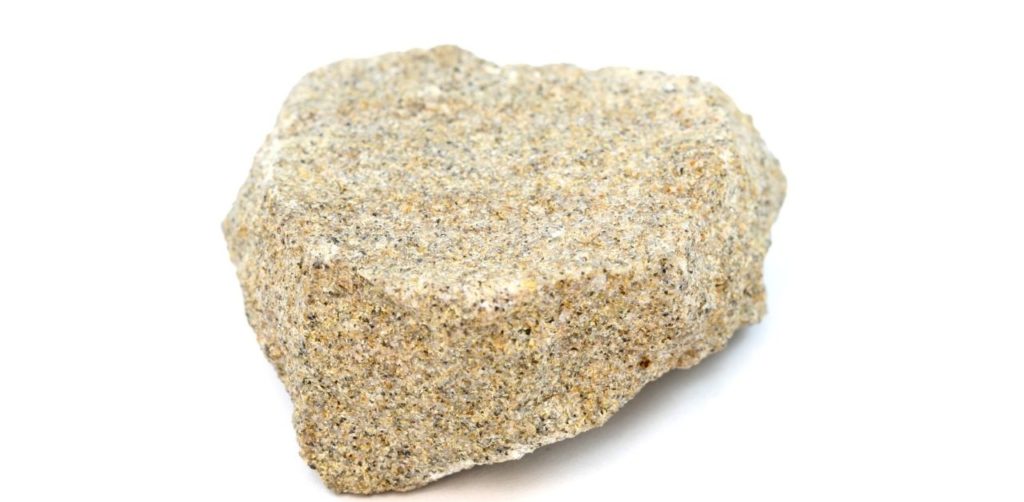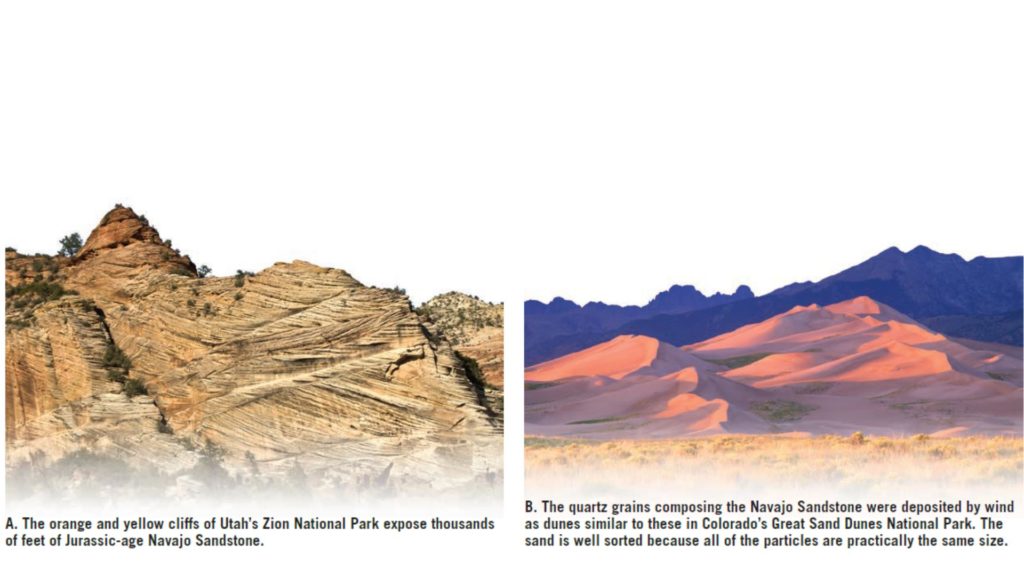Sandstone

Basic information about sandstone
Sandstone is the name given to rocks in which sand-size grains predominate. After shale, sandstone is the next most abundant sedimentary rock, accounting for approximately 20 percent of the entire group. Sandstones form in a variety of environments and often contain significant clues about their origin, including sorting, particle shape, and composition.
This rock is predominantly made up of quartz grains but is often accompanied by feldspar, mica, or other minerals. Grains may be cemented by silica, calcite, or iron oxides.
TEXTURE Sandstone is a medium-grained rock. The grains are usually well-sorted (grains all of a similar size) and can either be angular (gritstone) or rounded (sandstone).
ORIGIN Sandstones are extremely common rocks that form in a great variety of geological situations. The majority of sandstones, however, are accumulated in either water, usually marine, or as wind-blown deposits in arid continental areas.
Grain size: Medium
Classification: Detrital
Fossils: Invertebrates, Vertebrates, Plants
Grain shape: Angular, Rounded
Sorting
All the particles in sandstone are not necessarily identical in size. Sorting refers to the degree of similarity in particle size in a sedimentary rock. For example, if all the grains in a sample of sandstone are about the same size, the sand is considered well sorted. Conversely, if the rock contains mixed large and small particles, the sand is said to be poorly sorted.

By studying the degree of sorting, we can learn much about the depositing current. Deposits of wind-blown sand are usually better sorted than deposits sorted by wave activity. Particles washed by waves are commonly better sorted than materials deposited by streams. Sediment accumulations that exhibit poor sorting usually result when particles are transported for only a relatively short time and then rapidly deposited.

B. These modern dunes are among the highest in North America.
For example, when a turbulent stream reaches the gentler slopes at the base of a steep mountain, its velocity is quickly reduced, and poorly sorted sands and gravels are deposited.
Particle Shape
The shapes of sand grains can also help decipher the history of a sandstone. When streams, winds, or waves move sand and other larger sedimentary particles, the grains lose their sharp edges and corners and become more rounded as they collide with other particles during transport. Thus, rounded grains likely have been airborne or waterborne. Further, the degree of rounding indicates the distance or time involved in the transportation of sediment by currents of air or water. Highly rounded grains indicate that a great deal of abrasion and hence a great deal of transport has occurred.
Very angular grains, on the other hand, imply two things: that the rock materials were transported only a short distance before they were deposited or that some other medium may have transported them. For example, when glaciers move sediment, the particles are usually made more irregular by the crushing and grinding action of the ice.
Transport Affects Mineral Composition
In addition to affecting the degree of rounding and the amount of sorting that particles undergo, the length of transport by turbulent air and water currents also influences the mineral composition of a sedimentary deposit. Substantial weathering and long transport lead to the gradual destruction of weaker and less stable minerals, including the feldspars and ferromagnesians. Because quartz is very durable, it is usually the mineral that survives a long trip in a turbulent environment.
To summarize, the origin and history of sandstone can often be deduced by examining the sorting, roundness, and mineral composition of its constituent grains. Knowing this information allows us to infer that a well-sorted, quartzrich sandstone consisting of highly rounded grains must be the result of a great deal of transport. Such a rock, in fact, may represent several cycles of weathering, transport, and deposition. We may also conclude that a sandstone containing significant amounts of feldspar and angular grains of ferromagnesian minerals underwent little chemical weathering and transport and was probably deposited close to the source area of the rock particles.
What are the various types of sandstone?
Due to its durability, quartz is the predominant mineral in most sandstones. Such rock is often simply called quartz sandstone. When a sandstone contains appreciable quantities of feldspar (25 percent or more), the rock is called arkose. In addition to feldspar, arkose usually contains quartz and sparkling bits of mica. The mineral composition of arkose indicates that the grains were derived from granitic source rocks. The particles are generally poorly sorted and angular, which suggests short-distance transport, minimal chemical weathering in a relatively dry climate, and rapid deposition and burial.
A third variety of sandstone is known as graywacke. Along with quartz and feldspar, this dark-colored rock contains abundant rock fragments and matrix finergrained material in which the fragments are embedded.
More than 15 percent of graywacke’s volume is matrix. The poor sorting and angular grains characteristic of graywacke suggest that the particles were transported only a relatively short distance from their source area and were then rapidly deposited. Before the sediment could be reworked and sorted further, it was buried by additional layers of material. Graywacke is frequently associated with submarine deposits made by dense sedimentchoked torrents called turbidity currents.
